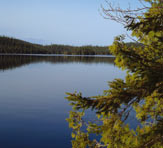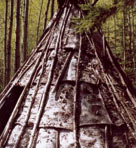  |
|
| |
Tools and References - General |
| |
Some of these materials are also included in other sections of this website. |
| |
|
| |
Go to: |
| |
Guidelines and resources for Aboriginal forestry |
| |
Data on Aboriginal forestry |
| |
General references on Aboriginal forestry |
| |
Miscellaneous case studies on Aboriginal forestry |
| |
Miscellaneous other articles on Aboriginal rights and participation in the forest sector |
| |
Funding sources for Aboriginal forestry |
| |
|
| |
|
| |
Guidelines and resources for Aboriginal forestry |
| |
Wendake Action Plan from Indigenous Peoples' Forest Forum of the XII World Forestry Congress (September 2003) |
| |
Forestry Toolbox. First Nations of Quebec and Labrador Sustainable Development Institute. |
| |
This toolbox is not available on-line, but may be obtained in a large binder or CD format by requesting it from the Institute. It is available in both French and English. Some of the material is specific to Québec, but most of it is relevant for any Aboriginal organization that needs to increase its capacity for dealing with forest issues. Click here to look at the table of contents. |
| |
National Aboriginal Forestry Association (NAFA). 1995. Aboriginal Forest Land Management Guidelines: A Community Approach |
| |
Sliammon First Nation and Ecotrust Canada. 2002. Kla-soms Kwuth Tooqen - A toolbox for responding to Crown Land Referrals |
| |
Smith, P. 2005. Community-based framework for measuring the success of Indigenous Peoples' forest-based economic development in Canada. In L. Merino and J. Robson (eds.), Managing the Commons: Indigenous Rights, Economic Development and Identity. Mexico: Consejo Civil Mexicano para la Silvicultura Sostenible A.C., The Christensen Fund, Ford Foundation, Secretaria de Medio Ambiente y Recursos Naturales, Instituto Nacional de Ecologia. Pp. 38-52. |
| |
Smith briefly reviews theoretical and methodological challenges of measuring "success" in the unique context of Aboriginal rights and participation in the forest sector. This is used as a basis for outlining a framework containing criteria for assessing forest-based development initiatives. The framework promotes an outcome of well-being and satisfaction by situating the four pillars of sustainable development (environmental, economic, social, and cultural) on a foundation of Aboriginal rights and institutional development. |
| |
Union of BC Indian Chiefs and Ecotrust Canada. 1999. Chief Kerry's Moose: A Guidebook to Land Use and Occupancy Mapping, Research Design and Data Collection
|
| |
This is a widely cited and used introduction to the requirements, considerations, and methods in the practice of land use and occupancy mapping. |
| |
Sustainable Forest Management for Timber, Furbearers and Forest Biodiversity: A Guide for Trappers, Furbearer and Forest Managers (Fur Institute of Canada 2006) |
| |
This report is also available in French. |
| |
Articles for Western Native News (Cortex Consultants 2003-2004) |
| |
Laurie Flahr prepared these articles to raise awareness of the support for First Nations forestry initiatives offered by Cortex, largely focused in BC. They cover topics such as balancing social and ecological health; forest enterprise modeling; and opportunities in new forest legislation in BC. |
| |
|
| |
|
| |
Data on Aboriginal forestry |
| |
British Columbia State of the Forests Report |
| |
This accessible on-line report provides data on a number of indicators related to Aboriginal forestry. |
| |
|
| |
|
| |
General references on Aboriginal forestry |
| |
Parfitt, B. 2006. True Partners: Charting a New Deal for BC, First Nations, and the Forests We Share. Canadian Centre for Policy Alternatives. |
| |
Anderson, R., and R. Bone. 2003. Natural Resources and Aboriginal People in Canada: Readings, Cases and Commentaries. Concord, ON : Captus Press. |
| |
Includes a good chapter devoted to forestry issues. |
| |
Wilson, J., and J. Graham. 2005.
Relationships between First Nations and the forest industry: The legal and policy context. Ottawa, ON: Institute on Governance, National Aboriginal Forestry Association, Forest Products Association of Canada, First Nations Forestry Program. |
| |
Notzke, C. 1994. Aboriginal Peoples and Natural Resources in Canada. North York, ON: Captus Press. |
| |
Includes a good chapter devoted to forestry issues. |
| |
Report of the Royal Commission on Aboriginal Peoples (1996) |
| |
This comprehensive landmark study includes, among much else, extensive discussion and recommendations regarding the rights and relationships of Aboriginal Peoples relative to lands and resources. |
| |
Effective partnerships: Institutions for shared forest management and community development (Treseder and Krogman 1998) |
| |
This is an annotated bibliography published by the Sustainable Forest Management Network. |
| |
|
| |
|
| |
Miscellaneous case studies on Aboriginal forestry |
| |
Krcmar, E., G.C. van Kooten, H. Nelson, I. Vertinsky, and J. Webb. 2006. The Little Red River Cree Nation's forest management strategies under a changing forest policy. The Forestry Chronicle 82(4): 529-537 |
| |
"In this study, we explore alternative strategies available to the Little Red River Cree Nations for meeting their projected socio-economic needs using the natural resources to which they have access. We analyze outcomes from mathematical programming models for various forest policy regimes, ranging from current sustained-yield management to sustainable forest management. The potential outcomes of the two approaches are analyzed using financial returns, harvest volumes and ecological impoacts. Results indicate that decision-makers face significant trade-offs in determining an appropriate management strategy for the forest lands they control. Our main conclusion is that economic development strategies for First Nations must diversify away from forest resources in the long run if they are to be successful." (Abstract) |
| |
Exploring Aboriginal forestry and ecosystem-based management: A case study of Cowichan Tribes (Hutton 2004) |
| |
|
| |
|
| |
Miscellaneous other articles on Aboriginal rights and participation in the forest sector |
| |
Plantations, Indigenous rights, and genetically modified trees (Petermann and Langelle 2006) |
| |
The landscape: Public opinion on Aboriginal and northern issues (Indian and Northern Affairs Canada 2005) |
| |
|
| |
|
| |
Funding sources for Aboriginal forestry |
| |
Aboriginal Funding Tool |
| |
This tool allows you to search for funding sources according to a number of different terms. |
| |
Social Sciences and Humanities Research Council of Canada - Aboriginal Research Pilot Program |
| |
This program offers substantial funding opportunities in a framework that is largely academic. However, in recent years SSHRC has been developing innovative approaches to extend the relevance of academic research to better meet the needs of communities and practitioners. |


